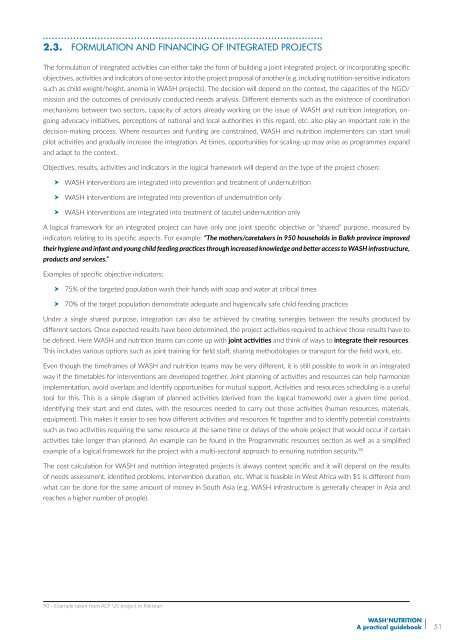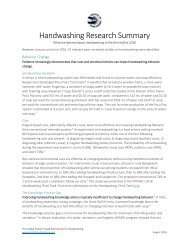WASH’ Nutrition
manuel_wash_nutrition_online
manuel_wash_nutrition_online
Create successful ePaper yourself
Turn your PDF publications into a flip-book with our unique Google optimized e-Paper software.
2.3. Formulation and financing of integrated projects<br />
The formulation of integrated activities can either take the form of building a joint integrated project, or incorporating specific<br />
objectives, activities and indicators of one sector into the project proposal of another (e.g. including nutrition-sensitive indicators<br />
such as child weight/height, anemia in WASH projects). The decision will depend on the context, the capacities of the NGO/<br />
mission and the outcomes of previously conducted needs analysis. Different elements such as the existence of coordination<br />
mechanisms between two sectors, capacity of actors already working on the issue of WASH and nutrition integration, ongoing<br />
advocacy initiatives, perceptions of national and local authorities in this regard, etc. also play an important role in the<br />
decision-making process. Where resources and funding are constrained, WASH and nutrition implementers can start small<br />
pilot activities and gradually increase the integration. At times, opportunities for scaling-up may arise as programmes expand<br />
and adapt to the context.<br />
Objectives, results, activities and indicators in the logical framework will depend on the type of the project chosen:<br />
WASH interventions are integrated into prevention and treatment of undernutrition<br />
WASH interventions are integrated into prevention of undernutrition only<br />
WASH interventions are integrated into treatment of (acute) undernutrition only<br />
A logical framework for an integrated project can have only one joint specific objective or “shared” purpose, measured by<br />
indicators relating to its specific aspects. For example: “The mothers/caretakers in 950 households in Balkh province improved<br />
their hygiene and infant and young child feeding practices through increased knowledge and better access to WASH infrastructure,<br />
products and services.”<br />
Examples of specific objective indicators:<br />
75% of the targeted population wash their hands with soap and water at critical times<br />
70% of the target population demonstrate adequate and hygienically safe child feeding practices<br />
Under a single shared purpose, integration can also be achieved by creating synergies between the results produced by<br />
different sectors. Once expected results have been determined, the project activities required to achieve those results have to<br />
be defined. Here WASH and nutrition teams can come up with joint activities and think of ways to integrate their resources.<br />
This includes various options such as joint training for field staff, sharing methodologies or transport for the field work, etc.<br />
Even though the timeframes of WASH and nutrition teams may be very different, it is still possible to work in an integrated<br />
way if the timetables for interventions are developed together. Joint planning of activities and resources can help harmonize<br />
implementation, avoid overlaps and identify opportunities for mutual support. Activities and resources scheduling is a useful<br />
tool for this. This is a simple diagram of planned activities (derived from the logical framework) over a given time period,<br />
identifying their start and end dates, with the resources needed to carry out those activities (human resources, materials,<br />
equipment). This makes it easier to see how different activities and resources fit together and to identify potential constraints<br />
such as two activities requiring the same resource at the same time or delays of the whole project that would occur if certain<br />
activities take longer than planned. An example can be found in the Programmatic resources section as well as a simplified<br />
example of a logical framework for the project with a multi-sectoral approach to ensuring nutrition security. 90<br />
The cost calculation for WASH and nutrition integrated projects is always context specific and it will depend on the results<br />
of needs assessment, identified problems, intervention duration, etc. What is feasible in West Africa with $1 is different from<br />
what can be done for the same amount of money in South Asia (e.g. WASH infrastructure is generally cheaper in Asia and<br />
reaches a higher number of people).<br />
90 - Example taken from ACF US project in Pakistan<br />
<strong>WASH’</strong><strong>Nutrition</strong><br />
A practical guidebook<br />
51



